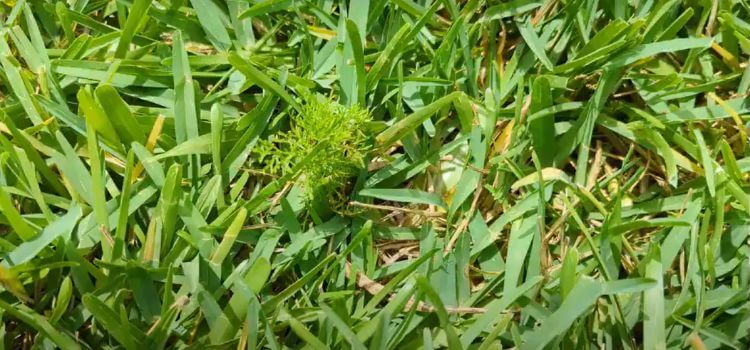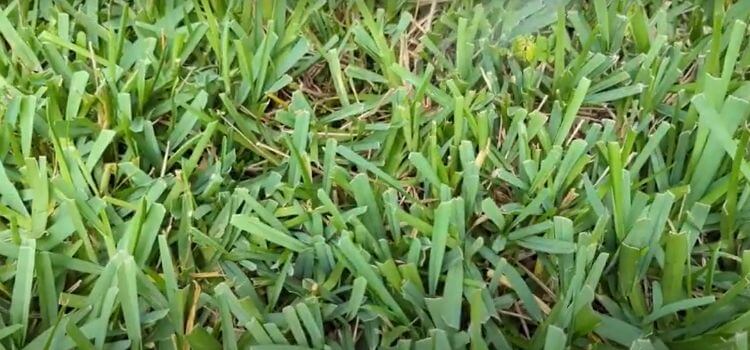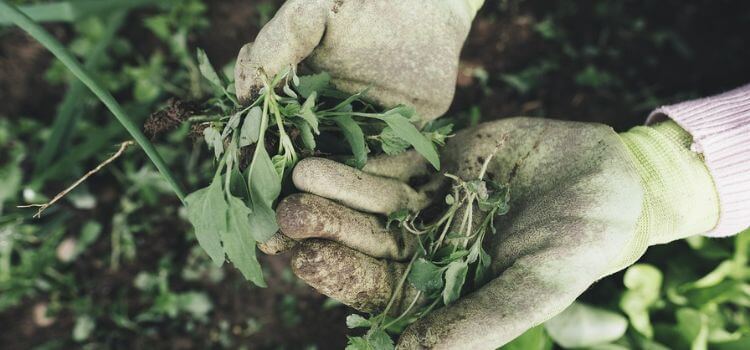As an Amazon Associate, I earn from qualifying purchases.
Types of weeds in St. Augustine grass include broadleaf, grassy, and sedges. Typical examples are dollarweed, crabgrass, and nutsedge.
St. Augustine grass, known for its lush, green appearance, often faces challenges from invasive weeds. Broadleaf weeds like dollar weed are frequent, thriving in moist conditions. Grassy weeds, such as crabgrass, compete for nutrients and space, stunting the growth of desired grass.
Sedges like nutsedge, identifiable by their triangular stems, are particularly problematic in poorly drained soils. Effective weed management in St. Augustine grass requires timely identification and appropriate control measures. By engaging in regular lawn maintenance, including proper mowing, watering, and fertilization, homeowners can take proactive steps to keep these invasive weeds at bay, ensuring a healthy, vibrant lawn.

Common Weeds In St Augustine Grass
St Augustine grass is famous for its lush, green appearance and ability to thrive in warm climates. However, this grass can often become home to various types of weeds. Common weeds in St Augustine grass can compete for nutrients, water, and sunlight, which can affect the health and appearance of your lawn. Identifying these weeds is the first step in maintaining a beautiful lawn.
Dollar weed
Dollar weed is a common weed in St Augustine grass. This weed is also known as pennywort. It has round, shiny leaves that resemble small, flat coins.
Dollar weed thrives in moist, shady areas. It can spread quickly through its underground stems. Key characteristics include:
- Round leaves with scalloped edges
- Shiny, green surface
- Grows in clusters
Control methods for Dollarweed include:
- Reducing irrigation to dry out the soil
- Applying a post-emergent herbicide
- Maintaining a thick, healthy lawn to prevent weed seeds from germinating
Crabgrass
Crabgrass is another troublesome weed in St Augustine grass. This weed is easily identified due to its coarse texture and sprawling growth habit. It can quickly take over weak areas of your lawn.
Characteristics of crabgrass include:
- Wide, flat blades
- Sprawling growth pattern
- Seed heads that resemble crab legs
Effective control methods for crabgrass are:
- Using pre-emergent herbicides in early spring
- Maintaining proper mowing height
- Ensuring your lawn is well-fertilized and irrigated
Goosegrass
Goosegrass is another common weed in St Augustine grass. This weed is often found in compacted soils and areas with heavy foot traffic. Its distinct white or silver centre can identify it.
Notable features of goosegrass include:
- Tufted growth habit
- Flat, white centre
- Leaves that lie flat against the ground
To control goosegrass, consider:
- Aerating compacted soil
- Applying pre-emergent herbicides
- Maintaining a healthy, dense lawn
Chickweed
Chickweed is a small, low-growing weed that can quickly spread through St Augustine grass. This weed has small, white flowers and can thrive in excellent, moist conditions.
Key identifiers of chickweed include:
- Small, white, star-shaped flowers
- Small, egg-shaped leaves
- Grows in dense mats
Controlling chickweed involves:
- Using post-emergent herbicides
- Maintaining proper lawn care practices
- Removing weeds by hand before they spread
Clover
Clover is a common weed found in St Augustine grass. It is easily recognizable by its three-leaf clusters and white or pinkish flowers. Clover can fix nitrogen from the air, giving it an advantage in poor soil conditions.
Identifying features of clover include:
- Three-leaf clusters
- White or pinkish flowers
- Grows low to the ground
Effective methods to control clover are:
- Applying broadleaf herbicides
- Improving soil fertility
- Maintaining a thick, healthy lawn

Weed Control Methods
St. Augustine grass, with its lush, green appearance and remarkable durability, is a source of pride for many homeowners. However, the intrusion of weeds can mar its beauty. Understanding effective weed control methods is key to preserving the splendour of your lawn. We will delve into various weed control methods to help you maintain the pristine beauty of your St. Augustine grass.
Preventive Measures
Preventing weeds from taking root in your St. Augustine grass is the first line of defence. The good news is, that these preventive measures are simple to adopt and can significantly reduce weed growth, empowering you to take control of your lawn’s health:
- Proper Mowing: Keep your grass at the recommended height of 2.5 to 4 inches. Taller grass shades the soil, preventing weed seeds from germinating.
- Regular Watering: Water deeply but infrequently. This encourages profound root growth, making your grass more competitive against weeds.
- Fertilization: Apply a balanced fertilizer during the growing season. Healthy grass outcompetes weeds for nutrients and space.
- Aeration: Aerate your lawn annually to reduce soil compaction. This improves water and nutrient penetration, promoting healthy grass growth.
- Mulching: Apply mulch to garden beds and around trees. Mulch suppresses weed growth and retains soil moisture.
Here’s a quick reference table for preventive measures:
| Preventive Measure | Action |
|---|---|
| Proper Mowing | Keep grass 2.5-4 inches tall |
| Regular Watering | Water deeply but infrequently |
| Fertilization | Use balanced fertilizer |
| Aeration | Aerate annually |
| Mulching | Apply mulch to suppress weeds |
Chemical And Non-chemical Control Options
Both chemical and non-chemical methods can effectively control weeds in St. Augustine grass. Here are some options:
Chemical Control:
- Pre-emergent Herbicides: These are a powerful tool in your weed control arsenal. Apply them before weed seeds germinate. They form a barrier that prevents weed seeds from sprouting, effectively stopping weeds before they even start. Post-emergent Herbicides: Use these to grow weeds actively. They target and kill weeds without harming your grass.
Spot Treatments: Apply herbicide directly to weeds. This method minimises the impact on surrounding grass so you can control weeds without worrying about harming your lawn.Non-Chemical Control:
- Hand Weeding: Remove weeds by hand, especially in small areas. Ensure you pull out the entire root to prevent regrowth.
- Soil Solarization: Cover the soil with clear plastic for 4-6 weeks. The sun’s heat kills weed seeds and pathogens.
- Vinegar Spray: Use a vinegar solution to spot-treat weeds. This natural method is adequate for small infestations.
Here’s a comparison table for chemical and non-chemical options:
| Method | Description |
|---|---|
| Pre-emergent Herbicides | Prevents weed seeds from germinating |
| Post-emergent Herbicides | Targets and kills active weeds |
| Spot Treatments | Applies herbicide directly to weeds |
| Hand Weeding | Manually removes weeds |
| Soil Solarization | Uses sun’s heat to kill weed seeds |
| Vinegar Spray | Natural method for small infestations |
Impact Of Weeds On St Augustine Grass
St Augustine grass is a popular lawn choice due to its lush, green appearance. However, weeds can invade and cause significant damage. The impact of weeds on St Augustine grass can profoundly affect lawn health and maintenance efforts.
Effects On Lawn Health
Weeds compete with St Augustine grass for essential resources. They steal water, nutrients, and sunlight, which weakens the grass. Weeds can also introduce diseases and pests to your lawn.
Here are some critical effects of weeds on lawn health:
- Reduced Nutrient Absorption: Weeds absorb nutrients faster than grass.
- Water Competition: Weeds take up more water, leaving grass thirsty.
- Sunlight Blockage: Taller weeds block sunlight from reaching the grass.
- Increased Pest Activity: Weeds can attract pests that harm grass.
Understanding Your Foes: The Different Categories of Weeds
| Type of Weed | Impact on Grass |
|---|---|
| Broadleaf Weeds | Compete for nutrients and sunlight |
| Grassy Weeds | Steal water and nutrients |
| Sedge Weeds | Attract pests and spread diseases |
Challenges For Lawn Maintenance
Maintaining a weed-free lawn is challenging. Weeds grow quickly and spread easily, and they can outcompete grass, making it hard to keep your lawn healthy.
Here are some common challenges faced during lawn maintenance:
- Frequent Weeding: Regular weeding is time-consuming and labor-intensive.
- Herbicide Use: Using a suitable herbicide is crucial but can be tricky.
- Mowing Difficulties: Weeds can make mowing uneven and rugged.
- Soil Health: Weeds can deplete soil nutrients, affecting grass growth.
Effective weed control involves a combination of strategies:
- Regular Monitoring: Check your lawn frequently for weed growth.
- Proper Watering: Water deeply but infrequently to discourage weeds.
- Fertilization: Use balanced fertilizers to promote grass health.
- Correct Mowing: Mow at the right height to keep the grass strong.
By understanding the impact of weeds on St Augustine grass, you can take steps to protect and maintain your lawn effectively.
Best Weed Management System
St Augustine grass is not just a lawn, but a canvas of lush, green beauty. However, it can also be a battleground for various types of weeds. This is why effective weed management is crucial, as well as a commitment to maintaining its beauty. This section will delve into the best weed management systems to keep your St Augustine grass pristine.
Regular Lawn Maintenance
Regular lawn maintenance is the first step in a successful weed management system. A well-maintained lawn is less likely to be overrun by weeds. Here are some essential practices:
- Mowing: Keep the grass at the recommended height of 2.5-4 inches. This height can shade out weed seedlings.
- Watering: Water deeply but infrequently. This encourages profound root growth for grass, making it more resilient against weeds.
- Fertilizing: Use a balanced fertilizer to ensure healthy grass growth. This knowledge empowers you to make the right choices for your lawn. Avoid over-fertilizing as it can encourage weed growth.Regular maintenance practices can be summarized in the table below:
Choosing The Right Herbicides
Choosing the suitable herbicides is essential for effective weed control. Not all herbicides are suitable for St Augustine grass. Here are some tips:
- Pre-emergent herbicides: Apply these in early spring and fall to prevent weed seeds from germinating.
- Post-emergent herbicides: Use these on existing weeds. Ensure they are safe for St Augustine grass.
- Selective herbicides: Target specific weeds without harming your grass.
When selecting herbicides, read the labels carefully. Look for products specifically designed for St Augustine grass. Applying herbicides at the right time enhances their effectiveness.
Frequently Asked Questions
How To Get Rid Of Weeds In Saint Augustine Grass?
Use a selective herbicide that is safe for Saint Augustine grass. Apply during early growth stages. Hand-pull visible weeds. Maintain healthy grass with proper mowing, watering, and fertilizing. Consistent lawn care prevents weed growth.
What Weeds Look Like St. Augustine Grass?
Common weeds that resemble St. Augustine grass include crabgrass, torpedo grass, and carpetgrass. These weeds can invade lawns, creating a similar appearance. Regular lawn maintenance helps prevent weed growth.
How To Identify Grassy Weeds?
Identify grassy weeds by their narrow leaves, parallel veins, and jointed stems. Check for rapid growth and seed heads.
How To Tell The Difference Between Crabgrass And St. Augustine Grass?
Crabgrass has thin, coarse blades and grows in clumps. St. Augustine grass has broader, flat blades and spreads via stolons. Crabgrass is light green, while St. Augustine is dark green.
What Are Common Weeds In St Augustine Grass?
Common weeds include crabgrass, dollarweed, clover, spurge, and nutsedge.
Conclusion
Identifying and managing weeds in St Augustine grass is crucial for a healthy lawn. Regular maintenance and proper care can prevent weed infestations. By understanding different types of weeds, you can apply the right treatments. Stay vigilant and proactive to keep your lawn lush and green.
Happy gardening!

